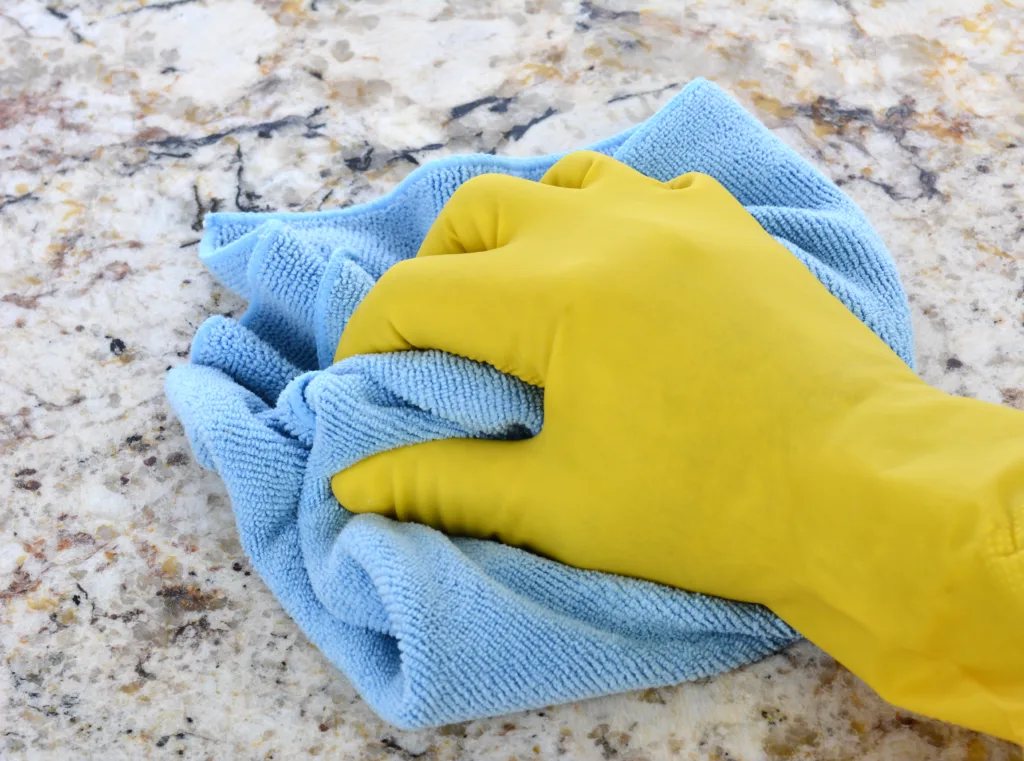Your countertop is a hub of activity, and should be tough enough to face every kitchen activity. Stone countertops are beautiful and hardy, perfect for kitchen countertops that come into contact with acid foods, hot cookery, and sticky fingers. Some countertop materials, like laminate and quartz, do not require sealing. However sealing stone countertops made of marble, granite, and quartzite is a way to ensure that they stay beautiful and strong.

How Can You Know If Your Countertop Is Sealed?
At the time of manufacture, stone countertops are almost always sealed to keep them in pristine condition for as long as possible. Depending on the kind of stone and the amount of use your countertops receive, resealing will be necessary to keep out stains.
How Long Do Sealants Last?
The longevity of a countertop sealant depends on many factors, including the kind of sealant applied, the material that was sealed, and the amount of wear and tear the seal experiences. Many sealers applied at the factory last 10–15 years. It is common for reseals to be good for 5–7 years, unless they fall under the DIY category. Some of these seals may only be good for 6–12 months. The best way to know whether your countertops need to be sealed is with a simple experiment.

Testing Your Seal
Even among the stones that are commonly sealed, not all slabs need to be. Generally if a slab of granite, for example, is darker in hue, it will be less permeable because of the pigmentation. At the time of manufacture, a rule of thumb is that if water darkens the stone, the stone needs a sealer. This is not a hard-and-fast rule, and every slab of stone is different.
If you want to discover whether or not sealing stone countertops is required in your kitchen, a simple test will do the trick. Take a ¼ cup of clean water and pour it on the countertop. Time how long it takes for the stone to become discolored or to absorb the puddle. If the water remains after a half an hour, your sealant is intact. If your stone darkens or the puddle shrinks before the 30-minute mark, your counter could do with a reseal. Perform this test on different areas of your countertop to see if the sealant has worn away faster in specific areas.
Is It Possible to Seal Stone Countertops Too Frequently?
To prevent staining, it may be tempting to really load up on the sealant you apply on the counter, you know, to cover the bases. This is inadvisable for two big reasons. Firstly, sealant is not as tough as your stone countertops. It seals off the stone’s pores but isn’t very strong itself, and thick layers of it are likely to manifest scratches and burns.
The other reason to apply sealant only when you need to is because if sealant pools on itself or builds up, it gives the countertop a dull appearance. Perform the water test to determine when sealant needs to be applied. Alternatively, other indications that sealing stone countertops is called for include moisture rings left behind by glasses and signs of etching or chipping. The latter two will need to be professionally repaired.
The Ins and Outs of Sealing a Stone Countertop
Sealing stone countertops can make them look like new. The process is relatively simple, especially when performed by professionals. First the countertop must be cleaned thoroughly to make sure sealant application is even and doesn’t trap any debris or bacteria inside. If the countertop is stained, the stains will need to be removed before the sealant is applied. Keep in mind that sealant does not give stone countertops a shiny finish. That effect is achieved through polishing.

Sealing Stone Countertops on Your Own
If you plan on sealing stone countertops on your own, there are a few things to consider. You must choose the right sealant for your countertop. Some sealants are water-based and environmentally friendly while solvent-based sealants may be a little better at penetrating the countertop’s stone. Read the sealant instructions through completely before beginning, and open the doors to improve ventilation. Wear gloves to protect your hands from the chemicals in the sealant. You can test the sealant on a discrete area of the countertop to make sure you like the look of it.
Sealing stone countertops entails spraying the sealant onto the countertop or rubbing it in with a clean cloth. Sealant should be applied evenly along the countertop and allowed to absorb for the allotted time recommended by the sealant manufacturer (usually 15–20 minutes). After that time, be sure to wipe the sealant off of the countertop with a clean cloth. If you forget this step, you can actually discolor the stone.
It may be necessary to apply the sealant a second time. If this is the case, simply repeat the process. Whether one or two coats are required, after excess sealant has been wiped away, you must give it plenty of time to set. This can mean not using the countertop for up to 48 hours.
Will a Sealed Countertop Stain?
While textured countertops hide flaws, that same quality can make stains difficult to find and clean. Some homeowners, worried about staining, opt for stone choices like quartz that are not porous. However, no material is truly impervious to stains just as no sealer is 100% stain-proof. Sealing countertops of granite and marble is a good way to protect them from spilled drinks or salad dressing wanting to leave their mark.

